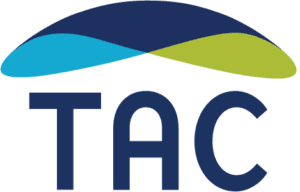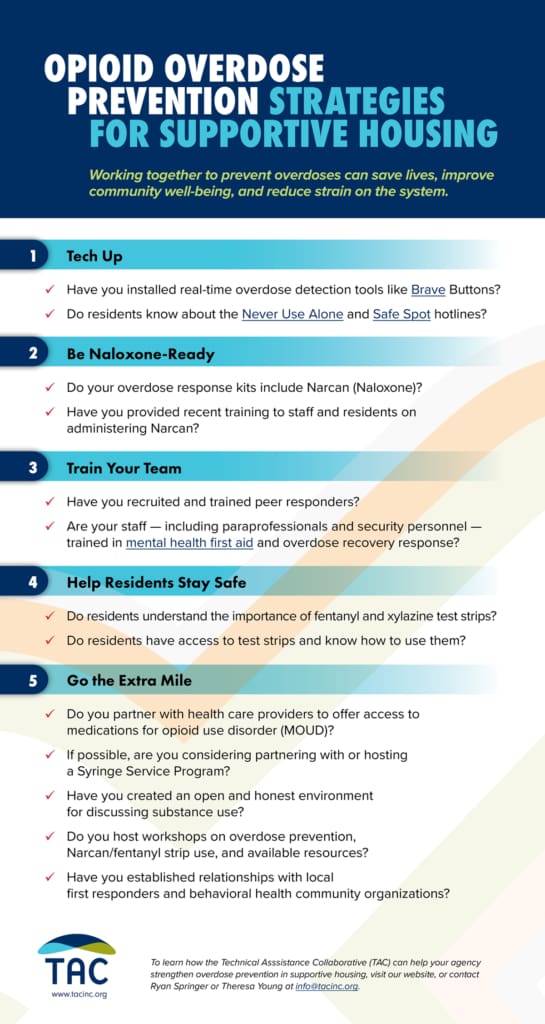Despite recent reductions, both overdoses and deaths related to opioids remain a significant public health threat across the United States. To make further progress against this ongoing crisis, it is imperative to address the unique challenges faced by specific groups — utilizing evidence-based practices, leveraging the power of technology, and strengthening partnerships. Supportive housing, whether offered in a congregate setting or in scattered site models, presents a critical opportunity to implement effective prevention strategies that can save the lives of people at an elevated risk of dying from an overdose.
Overdose prevention is an important part of providing safety in supportive housing. Not all residents transitioning from homelessness to housing are ready to reduce or eliminate their use of substances. Even for those who are working toward abstinence, returns to use are an expected part of the recovery journey. And finally, some supportive housing residents may engage only in occasional substance use — but overdose is a danger even for these individuals. People living outside or in congregate settings like shelters often have peers or staff nearby who are equipped to respond to an overdose; when a person moves into supportive housing, they may lose this built-in safety net. People who use drugs alone are at greater risk of dying from an overdose.
Overdose prevention requires a comprehensive approach — meaning that supportive housing leaders and funders must prioritize a holistic model that:
- Focuses on resident well-being and long-term recovery;
- Encompasses technology, harm reduction tools, community response, and evidence-based interventions; and
- Is created with the full involvement and input of tenants and others who use drugs routinely or who have a history of routine drug use.
Using Technology for Safety
- Overdose Detection Tools: Innovative technologies like the Brave sensor system can detect overdoses in real time, alerting staff or bystanders to intervene quickly. A 2023 study published in the International Journal of Environmental Research and Public Health identified such tools as emerging solutions in reducing overdose deaths.
- Virtual Support: The Safe Spot and Never Use Alone hotlines offer a virtual safety net, allowing people using substances to connect with trained operators who can provide support and summon help if needed. Initial research suggests that such programs can enable a rapid response to potential overdose events.
Harm Reduction in Action
- Naloxone access and training: Ready access to naloxone (Narcan), for instance by installing Naloxboxes or other overdose reversal kits, is an essential element of overdose prevention in supportive housing.
- Fentanyl and xylazine test strips: Equipping residents with fentanyl and xylazine test strips allows them to identify the presence of these potent substances in their drugs. This knowledge enables people to make more informed choices, potentially avoiding fatal overdoses.
- Staff trained in harm reduction principles and practices: Training staff on harm reduction interventions equips them to give residents information and strategies that can minimize the risk of overdose.
Community as First Responders
- Peer responders: Training residents to be peer responders fosters a sense of community and empowers them to take an active role in overdose prevention. Research has shown that peer-led interventions can be highly effective in reducing harm and promoting recovery.
- Trained program staff: Ensuring that program staff are well-trained in overdose response and Narcan administration provides an additional layer of support, and can significantly improve outcomes in emergency situations.
- Mental health first aid: Training non-clinical staff in mental health first aid enables them to recognize and respond appropriately to mental health crises, which often co-occur with substance use. In single-site supportive housing, trained staff should include security personnel and paraprofessionals.
Going Further: Integrating Evidence-Based Interventions
To build upon all these essential strategies, supportive housing program leaders should consider incorporating evidence-based interventions that have proved effective in reducing overdose risk and promoting recovery.
- Medication for opioid use disorder (MOUD): Partnering with health care providers to offer access to MOUD, such as methadone or buprenorphine, is a critical step in addressing the opioid crisis. A wealth of research demonstrates the effectiveness of MOUD in reducing overdose deaths and improving overall health outcomes.
- Syringe services programs (SSPs): Where feasible, partnering with or hosting an SSP can significantly reduce the risk of overdose and disease transmission by providing access to safe use supplies, safe disposal, and essential health services. A long history of research consistently shows that SSPs are associated with decreased rates of HIV and hepatitis C transmission.
- Open communication and support: Creating a safe and non-judgmental environment in which residents feel comfortable discussing substance use concerns is vital for building trust and encouraging individuals to seek help. A trauma-informed approach that addresses the complex interplay of substance use and mental health is particularly important in supportive housing settings.
Building a Network of Support
Successful overdose prevention requires supportive housing leaders to engage actively with the broader community. By building strong partnerships and fostering open communication, we can create a network of support that extends beyond the walls of supportive housing programs.
- Education and outreach: Hosting workshops and educational events on overdose prevention, Narcan/fentanyl strip use, and available resources helps to destigmatize substance use and empowers community members to respond effectively to overdoses.
- First responder collaboration: Strong relationships with local first responders can ensure a coordinated and efficient response during emergencies.
- Community partnerships: To create a comprehensive network of support for residents, it is essential to collaborate with local organizations specializing in SUD treatment, recovery support services, harm reduction, and mental health.
Using Data to Inform Interventions
Despite a modest national dip in opioid deaths in 2023, progress has been uneven. For instance, over the same period that produced an overall improvement, there were increases in overdose mortality for Black and Native American populations. Opioid deaths also rose nationally for seniors, and overall in several individual states. Communities should use data to identify the groups at greatest risk, and design engagement strategies so that the interventions described here can reach the people who need them most.
TAC’s Role: Partnering for Change
TAC is dedicated to assisting supportive housing providers and services partners in implementing multifaceted overdose prevention strategies. We offer consultation, resource-sharing, and technical assistance to help organizations develop and execute effective plans. Our team of experts can help you:
- Develop and implement equity-centered approaches that meet individuals at the intersections of their housing, health, and human service needs.
- Develop and implement capacity-building practices to address systemic issues that affect at-risk populations.
- Facilitate authentic community engagement that prioritizes the voices of people experiencing the greatest impact from the overdose crisis.
- Create trauma-informed programs and services tailored to the needs of your community.
- Secure funding and develop sustainable financial models for your overdose prevention initiatives.
Together, we can build a future where overdose is no longer a leading cause of death in any community.
Download a free one-page flyer that summarizes key approaches and action steps for policymakers, community leaders, supportive housing program directors, and residents.





